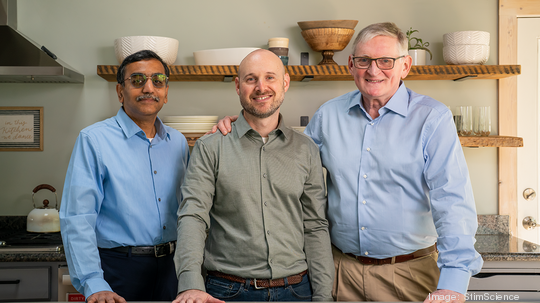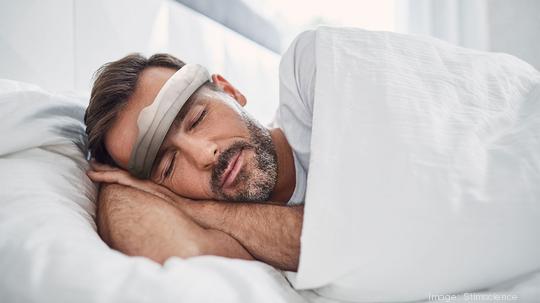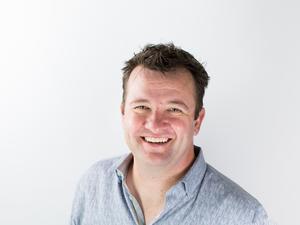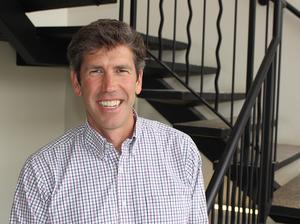
Berkeley-based StimScience launched its new product this week, an electronic sleep aid that promises to improve sleep quality. Dubbed Somnee, the device is a silk headband that users put on about 15 minutes before they go to bed that emits noninvasive brain stimulation, which can safely and effectively cut down on the time it takes to fall asleep as well as improve overall sleep quality.
I spoke with StimScience CEO Aaron Bromberg, who joined the company in March 2021, to understand exactly how the device works — and how I can get one.
So, tell me about why this tech is so important right now. Every aspect of mental and physical health is linked to a lack of sleep including type two diabetes and an increased risk of dementia or Alzheimer's disease, risk of injury, as well as mood and performance.
When most people think about sleep, they think of the sleep environment. You climb into bed and pull up the covers and close your eyes. But the reality is sleep is a brain activity. When you talk to sleep scientists, they talk about the neurology of sleep. As a brain activity, it's no surprise that all the memory foam and weighted blankets out there haven't done much to quell the growing sleep epidemic.
How exactly does Somnee work? It's a headband that the user will put on at bedtime for 15 minutes for a personalized stim session, and during that stim session, they'll get a gentle electrical current that precisely mimics the brain's natural sleep patterns, and then enhances those patterns to help to promote what the brain wants to do anyway, which is go to sleep. At the end of the 15 minutes, you can actually just take the headband off and go to sleep naturally if you don't want to sleep with it on.
Does the device collect any data on its wearer? So it starts by using a built-in EEG [electroencephalography] sensor, which is the same type of sensor used in sleep labs to measure brain activity. And it detects the wearer's sleep signature — it detects exactly what your specific brain patterns are as you're climbing into bed and getting drowsy. And then that's what allows us to apply the personalization algorithm that StimScience developed to mimic and enhance those frequencies.
Can or should users wear the headband all night? You can. There’s also an app and you'll be able to go in and see how your sleep has evolved over time and how Somnee is helping to improve your sleep. But more than that, if you sleep with it on, our algorithm will actually use that full night's sleep to further improve your next session.
So everybody's sleep evolves over time — most of us have a different sleep pattern on the weekend versus the weekday, and it can throw off our sleep patterns for the week. Some of these algorithms actually can incorporate all of that information and optimize your sleep so that if you are having trouble falling asleep, then the algorithms will shift towards the frequencies that will help you to improve your sleep onset.

How did the idea for Somnee come about? The company was founded by a dream team of neuroscientists from UC Berkeley that include Dr. Matthew Walker, who is a very well-known sleep scientist and a best-selling author — he wrote a book called “Why We Sleep” — and Dr. Robert Knight, UC Berkeley neuroscientist and practicing neurologist and Dr. Richard Ivry, who is a foremost expert on noninvasive brain stimulation.
These scientists recognized that by putting their expertise together, they could use brain stimulation and brain monitoring to directly improve sleep — that was the genesis of the company. And then after they hatched that idea in 2017, the company started operating a sleep lab in order to build out the science behind that idea. And we conducted three years of sleep studies in our lab, as well as 1,500 study nights at home as a pilot study in order to develop and validate our science.
How did the recent seed funding round improve the tech? We raised a total of $8.3 million led by Khosla Ventures with participation from Monozukuri Ventures as well as Great Eagle Holdings. With that funding, we’ve been able to advance the Somnee prototype into manufacturing and prepare it for launch.
In terms of the team, we've brought on some experienced product leaders. And then of course, we brought me on with my experiences with Amazon, as well as boosted boards and we've also invested heavily and further prototyping the design and starting to purchase components for mass production.
What has the general reaction among users been so far? That 1,500-plus per night at home pilot study had impressive results. On average, it cut the time that it took people to fall asleep in half, and it reduced the amount of overnight tossing and turning by more than a third. For context, that's better than any sleeping pill.
It's a huge result that is going to really move the needle on public health once we roll it out to the hundreds of millions of people that struggle with sleep.
People are not just struggling with sleep because of the pandemic, but they're struggling with anxiety in some cases or stress and that increases the challenges that they have already with sleeping. Folks are really excited when we tell them what we're working on sleep quality because we're offering them something that is safe, easy and effective.
Somnee is available for pre-order starting at $179 and will be shipped in fall 2022.








